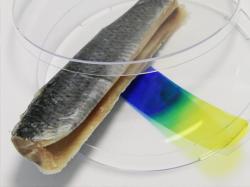New Sensor Indicates The State Of Your Meat
April 5, 2011 | 2 min to read

When it comes to packaged fish or meat, it is nearly impossible to distinguish between fresh goods and their inedible counterparts. Researchers have now developed a sensor film that can be integrated into the package itself, where it takes over the role of quality control. And if the food has spoiled, it changes color to announce the fact.
Is the vacuum-packed chicken leg really still fresh and edible? Looks alone do not tell the whole story. And the “best-before” date is no guarantee, either. Scandals involving the sale of rotten meat have added to the uncertainty, and the customer him- or herself may be shortening the shelf life through improper storage. This is an area in which a sensor film developed by the Fraunhofer Research Institution for Modular Solid State Technologies EMFT in Munich can immediately give a green – or rather: yellow light, or warn of spoiled goods. EMFT developed the film in a project sponsored by the German Federal Ministry of Education and Research.
The sensor film is integrated into the inside of the packaging, where it responds to biogenic amines. Amines are molecules produced when foods – fish and meat foremost among them – decay. They are also responsible for their unpleasant smell. If amines are released into the air within the packaging, the indicator dye on the sensor film reacts with them and changes its color from yellow to blue. “Once a certain concentration range is reached, the color change is clearly visible and assumes the task of warning the consumer,” explains Dr. Anna Hezinger, a scientist at EMFT. This is not only interesting when it comes to identifying foods that have become inedible. Many people are also extremely sensitive to the presence of certain amines. Which makes a warning all the more important for them.
To read the rest of the story, please go to: Fraunhofer Research Institution
